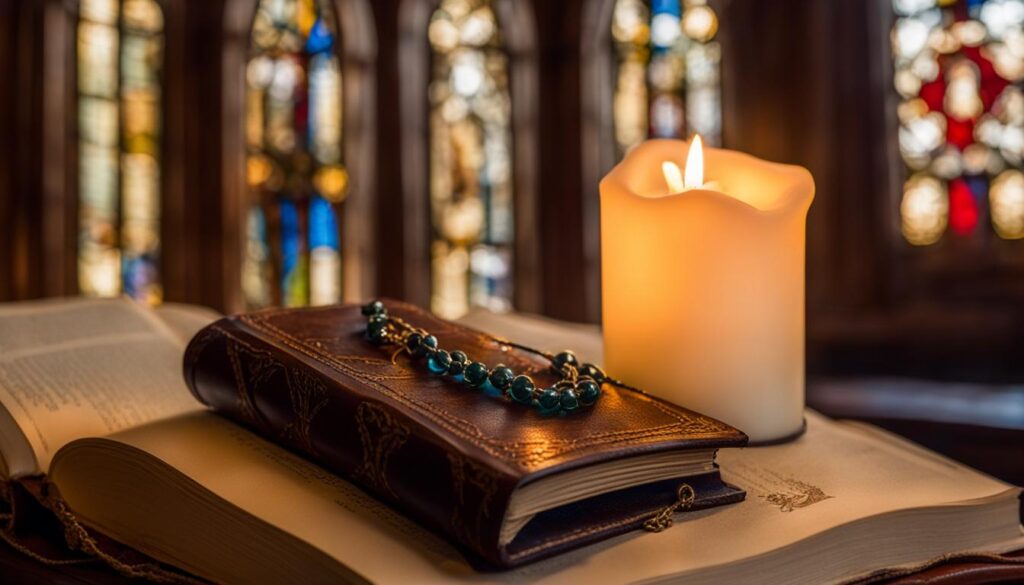Are you curious about the spiritual practices that have shaped the Catholic tradition? Look no further. In this article, we will take a deep dive into the world of praying Catholic tradition in the US. From its rich history to its transformative power, we will explore the significance of some of the most important prayers in the Catholic tradition.
Key Takeaways:
- The Catholic tradition is steeped in a rich history of prayer practices.
- Rote prayers, passed down through generations, hold deep spiritual significance for Catholics.
- Important prayers in the Catholic tradition include the Our Father, the Hail Mary, and more.
- The Rosary is a cherished prayer practice known for its transformative power.
- Modern Catholics engage in personal prayer practices alongside traditional prayers.
The Significance of Rote Prayers in the Catholic Tradition
Rote prayers, also known as memorized prayers, play an essential role in the Catholic tradition. These traditional prayers have been passed down through generations and hold deep spiritual significance for Catholics. They provide a foundation for personal prayer and serve as a way to connect with the divine.
These prayers, such as the Our Father and the Hail Mary, offer a structure and familiarity that can bring comfort and a sense of continuity to Catholics in their spiritual practices. Through the repetition of these prayers, believers can enter into a meditative state, allowing the words to penetrate their hearts and minds, fostering a sense of stillness and reverence.
While some may argue that rote prayers can become monotonous or lose their meaning when recited without reflection, for many Catholics, these prayers serve as a foundation upon which personal prayer and contemplation can be built. They offer a sense of unity with the wider Catholic community, linking believers across time and space in a shared language of faith.
The significance of rote prayers lies not only in their ability to provide structure and tradition but also in their capacity to lead individuals deeper into their personal relationship with God. By surrendering to the familiar cadence and rhythm of these prayers, Catholics can create a space for connection, reflection, and transformation in their spiritual lives.
Exploring the Most Important Catholic Prayers
In the Catholic tradition, prayer plays a central role in fostering a deep spiritual connection with God. By engaging in specific prayers, Catholics can express their faith, seek guidance, and experience a profound sense of peace and solace. In this section, we will explore some of the most important prayers in the Catholic tradition, shedding light on their significance and the role they play in the lives of believers.
The Our Father
One of the most well-known and widely recited prayers in the Catholic tradition is the Our Father, also known as the Lord’s Prayer. It is a deeply meaningful prayer that Jesus Himself taught to His disciples. In this prayer, Catholics address God as their Father and express their trust in His providence and forgiveness. The Our Father serves as a guide for personal prayer and a reminder of the importance of seeking God’s will in all aspects of life.
The Hail Mary
Another significant prayer in the Catholic tradition is the Hail Mary. This prayer focuses on the Virgin Mary and her role as the Mother of Jesus. By reciting the Hail Mary, Catholics seek her intercession and invoke her assistance and protection. The Hail Mary is a powerful prayer that highlights the belief in Mary’s special relationship with God and her ability to advocate for believers.
The Apostles’ Creed
The Apostles’ Creed is a statement of faith that summarizes the core beliefs of the Catholic Church. It serves as a declaration of the fundamental teachings and tenets of the Catholic faith. By reciting the Apostles’ Creed, Catholics affirm their belief in the Holy Trinity, the Church, and the resurrection of Jesus Christ. This prayer is often recited during Mass and other liturgical services as a way to profess and strengthen one’s faith.
The Act of Contrition
The Act of Contrition is a heartfelt prayer of repentance and a plea for God’s forgiveness. It is often recited during the Sacrament of Reconciliation or in times of personal reflection. By acknowledging their sins and expressing sincere remorse, Catholics seek reconciliation with God and a renewed commitment to live a virtuous life. The Act of Contrition is a prayer that highlights the importance of seeking forgiveness and striving for spiritual growth.
In summary, Catholic prayers hold immense significance in the lives of believers. The Our Father, the Hail Mary, the Apostles’ Creed, and the Act of Contrition are among the most important prayers in the Catholic tradition. These prayers serve as a means to connect with God, express faith, seek intercession, and seek forgiveness. By understanding the meanings and intentions behind these prayers, Catholics can deepen their spiritual connection to the Catholic faith and experience the transformative power of prayer.
The Transformative Power of Praying the Rosary
Praying the Rosary is a cherished prayer practice in the Catholic tradition, known for its transformative power and deep spiritual significance. This method of prayer involves meditating on the life of Jesus and the Virgin Mary while reciting specific prayers, such as the Hail Mary and the Our Father. The repetition of these prayers and the focus on the mysteries of the Rosary create a sense of peace, contemplation, and connection with the divine.
“The Rosary is a powerful tool for spiritual growth and healing,” says Father David, a Catholic priest with decades of experience in guiding his congregation. “When we pray the Rosary, we enter into a profound dialogue with God and Mary. It allows us to reflect on the life, death, and resurrection of Jesus, and to seek their intercession for our intentions.”
Through the centuries, countless Catholics have found solace, guidance, and spiritual growth through the practice of praying the Rosary. It is a prayer method that transcends time and cultural boundaries, offering believers a tangible way to deepen their faith and cultivate a closer relationship with God. The rhythm of the Rosary beads and the repetitive nature of the prayers create a sense of calm and focus, allowing individuals to center their thoughts and open their hearts to God’s presence.
Praying the Rosary is not only a personal spiritual practice but also a communal one. Many Catholic communities come together regularly to pray the Rosary, emphasizing unity, shared faith, and the power of collective prayer. It is a tradition that has been passed down through generations, bringing families and communities closer to God and to each other.
| Mysteries of the Rosary | Days of the Week |
|---|---|
| The Joyful Mysteries | Mondays and Saturdays |
| The Sorrowful Mysteries | Tuesdays and Fridays |
| The Glorious Mysteries | Wednesdays and Sundays |
| The Luminous Mysteries | Thursdays |
Praying the Rosary is a beautiful and powerful way to deepen one’s faith and experience the transformative power of prayer. Whether practiced individually or in a community, the Rosary offers a tangible and meaningful connection to the Catholic tradition and a pathway to a closer relationship with God.
Personal Anecdotes and Modern Catholic Prayers
In addition to traditional prayers, modern Catholics also engage in personal prayer practices that reflect their individual spiritual journeys. These personal prayer methods allow Catholics to deepen their connection with God and seek guidance in their daily lives. While traditional prayers have a structured format, personal prayers offer a more intimate and spontaneous way to communicate with the divine.
One popular form of personal prayer is extemporaneous prayer. This type of prayer is heartfelt and spoken in the moment, without following a set script or words. It allows individuals to express their own thoughts, feelings, and needs to God, offering a more personal and direct form of communication. Extemporaneous prayer offers a sense of freedom and authenticity, allowing individuals to fully express themselves in their own words.
Another modern Catholic prayer method is journaling. Many Catholics find solace in writing down their thoughts, reflections, and prayers in a journal. It provides a space for self-reflection, spiritual exploration, and documenting their journey of faith. Journaling helps individuals to articulate their thoughts and feelings, and it can serve as a source of guidance, inspiration, and self-discovery.

Contemplative prayer is another personal prayer practice that has gained popularity among modern Catholics. This form of prayer involves entering into a deep state of contemplation and silence, allowing individuals to connect with God in a more profound and mystical way. It is a silent prayer of the heart, where individuals seek to be present in the presence of God, opening themselves up to divine love and guidance.
Praying with Saints and Catholic Devotions
Catholicism has a rich tradition of devotional practices that complement personal prayer. These devotions involve seeking the intercession of specific saints and engaging in various rituals that have been passed down through generations. By participating in these devotions, Catholics deepen their spiritual connection to the Church and draw closer to the divine presence.
One popular Catholic devotion is the Novena, a nine-day prayer series that focuses on a particular saint or intention. The Novena allows Catholics to seek the intercession of the saint and ask for their guidance and support in their daily lives. This practice not only fosters a deeper connection with the saint but also cultivates a sense of unity with the wider Catholic community.
The Stations of the Cross is another cherished devotional practice in the Catholic tradition. This devotion involves meditating on the events leading up to Jesus’ crucifixion and death. Each station represents a different moment in Jesus’ journey to Golgotha, and Catholics reflect on his sacrifice and offer prayers of gratitude and repentance. The Stations of the Cross serve as a powerful tool for spiritual reflection and a reminder of Jesus’ ultimate sacrifice.
Additionally, the Litany of Saints is a unique Catholic devotion that involves reciting a series of prayers to invoke the intercession of multiple saints. Catholics recite the names of various saints, asking for their prayers and guidance. The Litany of Saints is often used during important liturgical celebrations and is a powerful way to seek the support of the communion of saints in heaven.
| Devotion | Description |
|---|---|
| Novena | A nine-day prayer series focused on a specific saint or intention, seeking their intercession |
| Stations of the Cross | Meditating on the events leading up to Jesus’ crucifixion and death, reflecting on his sacrifice |
| Litany of Saints | Reciting prayers to invoke the intercession of multiple saints, seeking their prayers and guidance |
“Devotional practices like praying with saints and engaging in Catholic rituals provide a profound way for believers to connect with their faith and seek spiritual support. These practices have been handed down through generations and continue to be cherished by the Catholic community.”
Praying with saints and engaging in devotional practices is an integral part of the Catholic tradition. These rituals not only deepen one’s personal relationship with God but also foster a sense of belonging to a global community of believers. Through the intercession of saints and the power of these devotions, Catholics find solace, guidance, and a greater understanding of their faith.
The Timeless Beauty of Catholic Prayers
Throughout history, the prayers of the Catholic tradition have captivated the hearts and minds of believers. These traditional prayers hold a timeless beauty that continues to inspire and provide solace to millions of Catholics. Their elegance and depth have stood the test of time, grounding believers in their faith and fostering a sense of unity within the Church.
One such prayer is the Our Father, also known as the Lord’s Prayer. This prayer, taught by Jesus himself, encompasses the core teachings of the Catholic faith and serves as a foundational prayer for believers. Its words have been recited for centuries, connecting generations of Catholics and creating a sense of continuity in the worship of God.
The Hail Mary is another prayer that resonates deeply with Catholics. It is a beautiful invocation of the Virgin Mary, seeking her intercession and reflecting on her role as the Mother of God. The Hail Mary captures the essence of Mary’s humility, grace, and devotion, offering a powerful prayer to turn to in times of need.
The Act of Contrition is a prayer of repentance and seeking forgiveness from God. It acknowledges our sins and asks for His mercy and healing. This prayer reminds Catholics of the importance of acknowledging and repenting for our wrongdoings, and it guides us on the path of reconciliation with God and our fellow believers.
Traditional Catholic Prayers
Table: Traditional Catholic Prayers
| Prayer | Description |
|---|---|
| Our Father | A prayer taught by Jesus, encompassing the core teachings of the Catholic faith. |
| Hail Mary | An invocation of the Virgin Mary, seeking her intercession and reflecting on her role as the Mother of God. |
| Act of Contrition | A prayer of repentance, seeking forgiveness from God and reconciling with fellow believers. |
These traditional Catholic prayers, along with many others, hold a profound significance in the lives of believers. They provide a sense of connection to the past, linking us to the long history of the Catholic faith. The beauty and power of these prayers continue to inspire and guide Catholics in their spiritual journeys, offering a source of comfort, strength, and communion with God.

Conclusion
Praying the Catholic tradition holds immense significance in the lives of believers, offering a profound way to connect with God and deepen one’s faith. By embracing the richness of the Catholic prayer tradition, individuals can embark on a transformative journey of spiritual growth and enlightenment.
Through the centuries-old prayers and devotions, Catholics can find solace, inspiration, and a sense of belonging to a global community of believers. The praying Catholic tradition unites individuals from different walks of life and fosters a deep connection to the divine presence.
Whether engaging in rote prayers, exploring the timeless beauty of traditional prayers, or incorporating personal prayer practices, the Catholic tradition provides a diverse range of avenues to seek guidance and find comfort. The transformative power of praying Catholic tradition has endured throughout history and continues to enrich the lives of millions of believers.
FAQ
What are rote prayers?
Rote prayers, also known as memorized prayers, are traditional prayers that have been passed down through generations in the Catholic tradition. They play a vital role in personal prayer and provide a way to connect with the divine.
What are some of the most important prayers in the Catholic tradition?
Some of the most important prayers in the Catholic tradition include the Our Father (or the Lord’s Prayer), the Hail Mary, the Apostles’ Creed, and the Act of Contrition. These prayers hold deep spiritual significance and help Catholics deepen their connection to the faith.
What is the Rosary?
The Rosary is a cherished prayer practice in the Catholic tradition. It involves meditating on the life of Jesus and the Virgin Mary while reciting specific prayers. Praying the Rosary has been known to bring about inner peace, spiritual growth, and a closer relationship with God.
Do modern Catholics engage in personal prayer practices?
Yes, modern Catholics also engage in personal prayer practices. These may include extemporaneous prayers, journaling, and contemplative prayer. Personal prayer is an important part of a modern Catholic’s spiritual journey.
Are there devotional practices in the Catholic tradition?
Yes, Catholicism is rich in devotional practices. These may include the Novena, the Stations of the Cross, and the Litany of Saints. Catholics engage in these devotions to seek the intercession of saints and deepen their spiritual connection to the Church.
Are traditional Catholic prayers still relevant today?
Yes, the prayers of the Catholic tradition are timeless in their beauty and power. They have resonated with millions of believers throughout history and continue to create a sense of unity and solace among believers today.
How can praying the Catholic tradition benefit individuals?
Praying the Catholic tradition offers a profound way to connect with God, seek guidance, and deepen one’s faith. Through centuries-old prayers and devotions, Catholics can find comfort, inspiration, and a sense of belonging to a global community of believers.








